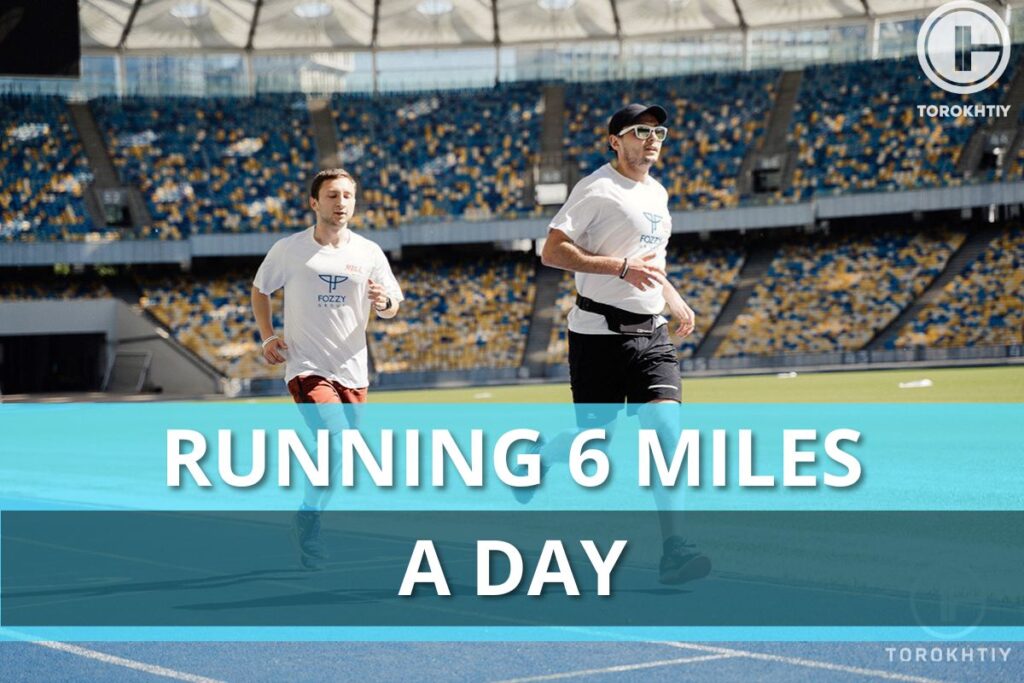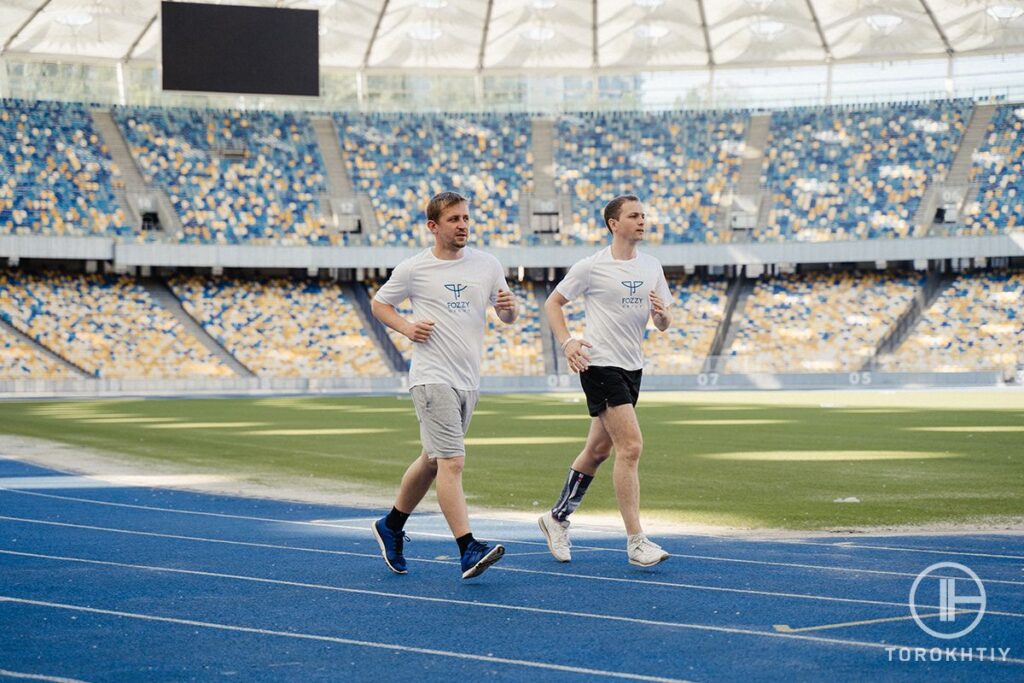Running 6 Miles A Day: Everything You Need To Know To Do It Right
Author:
Unlock your full potential by engaging with our experts and community! Have questions about your fitness journey or looking for expert advice on weightlifting techniques? Don’t hesitate — leave a comment below and Oleksandr Zagrebelnyi will provide a personalized answer and insights to help you reach your goals.
Torokhtiy is reader-supported. Some links are affiliate links, and we may earn a commission at no extra cost to you. See our disclosure page for details.
Running 6 miles a day is a very popular distance among fans of long runs. All of us have a different motivation for playing sports. Some want to lose weight, others want to improve their health, and someone plans to pump up lean muscles. Running can help in all of these points. If you want to make 6 miles your daily running routine, there are a few things you need to know.
How does running 6 miles every day affect your health? Does it have beneficial effects and risks? How to lose weight by running and preparing for an effective race? What is running 6 miles a day transformation in your body? Let’s discuss all the details in this article!
Running 6 miles a day suits amateur long-distance runners and experienced athletes. It can help you lose weight, improve endurance and overall health, tone your body, and prepare it for long runs. However, this distance requires some preparation and a training plan.

What Running 6 Miles A Day Can Do For You?
Is running 6 miles a day good for your body? With the right preparation, running 6 miles can bring you many benefits.
Running increases your body tone, enriches cells with nutrients, boosts the heart muscle, and improves the health of the internal organs during deep breathing. In addition to improving health, it also helps in losing weight. Let’s look at all the benefits of running in more detail.
1. The Cardiovascular System
With an increased heart rate, blood is actively carried through the body. As a result, you get an acceleration of metabolic processes and a saturation of organs with blood and oxygen.
Running makes your heart stronger.
Running 6 miles daily helps strengthen the walls of the heart and increase its systolic volume. All this reduces the risk of heart disease, particularly heart attack and heart failure.
If you want to improve your heart health, choose jogging or a slow pace during which you don’t have short breath. Regular runs in this mode have a great healing effect. Moderate 6-mile running leads to a 30% reduction in cardiovascular disease risk.
2. Respiratory System
When you practice 6 miles-a-day running, your body is controlled by two main organs – the lungs and the heart. The lungs supply your body with the main source of energy – oxygen. They also remove carbon dioxide from your body, which is the result of metabolic processes.
When you run long distances, your body works harder, and your muscles absorb more oxygen, producing more carbon dioxide. In order to cope with such a load, the lungs increase the frequency of breathing from about 13-17 times per minute to 40-60 times.
The amount of oxygen consumed increases by 8-10 times. Circulation increases to deliver oxygen to the muscles and maintain the load. The lungs are better ventilated, their volume increases, and your respiratory system becomes stronger.

3. Muscles And Joints
Running makes the muscles of the whole body work intensively – legs, arms, back, and abs. As a result, running boosts mobility and helps tone the whole body. A long run makes your body use many muscles, making them stronger and more resilient, allowing you to increase the distance.
Skeletal muscles are the basis of our body. They form posture and are responsible for basic body movements and breathing. These small changes as a result of running have great importance for our health, although we do not even notice them.
But, perhaps, many athletes noticed changes in their bodies after the first serious training. Strength, tone, muscle elasticity – all these are pleasant effects of running activity.
Surely you have heard that running harms the joints, especially the knees. However, it is not true. A 2008 study by Stanford University published in the American Journal of Preventive Medicine found that the progression of knee osteoarthritis in runners and non-runners was similar over an 18-year period.
That is, in the group of runners, there were no more such cases than in the control group.
However, you should remember that choosing the wrong running shoes, too high loads, and being overweight can lead to joint problems. If you follow the rules and listen to your body, there will be no health risks.
4. Digestive System
It would seem that running can only have a beneficial effect on the muscles and the musculoskeletal system, but its positive effect also extends to human digestion. As a result of the digestive processes, the food entering the body is broken down into nutrients, which are then delivered to the tissues.
When you run, your body requires more nutrients. Consequently, the digestive organs work more intensively, and gastric and intestinal secretion increases. Running reduces the risk of liver diseases and getting stones in the gallbladder.
5. Mental Health
Have you ever felt the runner’s high? Stress relief is probably the most pleasant effect of running 6 miles. Any activity, and running in particular, protects you from nervous tension due to the production of the hormone of happiness – endorphin. Excess adrenaline and cortisol in the body are burned during a run with the right intensity.
Regular running is an excellent remedy for anxiety and insomnia. When you move, your sleep improves, followed by overall well-being and high mental performance.
Have you noticed how calm you are after running? An evening run at an average pace is particularly useful for releasing negative emotions.
How Many Kilometers Are In 6 Miles? One mile is equal to 1.60934 km. According to this conversion, 6 miles = 9.65 km (rounded). Often, runners can round up this distance to 10K, which is 6.2 miles when converted.
Is Running 6 Miles A Day Enough For Weight Loss?
While running, your body spends a lot of energy. On average, it burns 500 kcal per hour of the slow run. Sounds like a great way to lose weight, right? But it is important to understand that weight loss happens not due to running itself but due to maintaining a calorie deficit – when you spend more energy than you consume.
Fat is the energy resource of our body. Therefore, active cardio workouts are best for weight loss. They increase energy consumption and start fat-burning processes. There are several important rules that will help you increase the effectiveness of running for weight loss:
- Duration. Short runs do not affect weight loss. To lose weight, you need long workouts: try to run for at least 40-50 minutes for active fat burning. First, your body will use up its stores of carbs and then move on to fats. Running 6 miles a day to lose weight is a great way to tone up your body.
- Pace. Choose an average speed to save your strength and energy. If your goal is to lose weight, then tune in to a calm run without high-speed intervals.
- Avoiding high-carb snacks before a run. For active weight loss, it is better for you to refuse a plentiful carbohydrate snack before training. Otherwise, your body will burn fast carbs instead of internal fat stores.
- Training schedule. To lose weight, try to exercise more often. If to strengthen the muscles, it is enough to run 6 miles a week; then, with weight loss, everything is different. For noticeable results, try to do 4-5 long runs per week to provide the body with the necessary cardio load.

Remember an important rule: you can lose weight only when you do not compensate for the lost energy by increasing calories. The body switches to its own fat reserves only with a calorie deficit.
Try to mix high-intensity workouts with slow running so your body will not get used to the monotonous load and will develop muscles for burning more calories. During a high-intensity workout, not fats are mainly used, but the glycogen contained in the muscles and liver. If you do not replenish it after the run, your body continues consuming glycogen, ruining your recovery.
Can Running 6 Miles A Day Be Bad For You?
It is important to understand that intensive (interval, tempo) training and participation in competitions lead to an increase in blood pressure and the tone of blood vessels. Before you start running in high heart rate zones, you need to balance the pressure so as not to create a threat to the cardiovascular system at the time of peak loads.
You need to consider three main criteria by which you can determine whether your body is ready for running.

- You can talk while running. If you can talk while running, and you are not short of breath, then most likely, you have chosen a pace that is safe for you. You run in 1 or 2 heart rate zones, which are safe for the long run.
- You can breathe through your nose while running. If you are running and your breathing is even, you can breathe through your nose – this is another sign that your pace is safe for your health.
- You feel no pain after running. This also means that you have received a good running load. If these three criteria are met, and you feel good, then you have a relatively correct running pace.
If you have been running successfully for a long time, this does not mean that you do not need to control your body. It is very dangerous to get overtrained, and, as a result, running will not benefit your health. Don’t forget your rest day and listen to your body.
How Long Does It Take To Run 6 Miles?
If you’re thinking about starting a 6-mile run, you might be interested in the average time for this distance. Of course, your time depends on experience, running pace, gender, age, and other factors. However, there are averages that you should aim for.
Amateurs and beginners usually do training runs at about 10 minutes per mile, and their total 6-mile run time is about one hour. As for racing 6 miles, usually experienced men cover this distance in 47-50 minutes, while women need about 55 minutes.
If you are just starting to run 6 miles, choose a comfortable pace, and don’t try to get close to 1 mile in 10 minutes right away. You may need to make stops or keep walking. However, regular exercise will help you improve your performance.
Running Time Calculator: Estimated Duration For A 6-Mile Run Daily
It’s crucial to recognize that running a rigorous 6 miles a day varies based on experience, running pace, gender, age, and other factors. Nonetheless, there are average benchmarks you can aim for. If you want to know how long it will take, you can use our time calculator.

How To Prepare For A 6-Mile Run?
When preparing for your first 6-mile runs, you should train your body gradually. How to run 6 miles without stopping? We’ve put together some important tips to make your long runs safe and productive.
1. Don’t Ignore Warm-Ups
Many runners neglect the warm-up, while it is extremely important for an effective workout. Without it, you risk getting an injury, overloading your heart, and not enjoying your run. At the same time, a warm-up helps set the right mood and prepare for the upcoming workout.
Warming up will be especially useful if you have a sedentary job. After spending a whole day in a chair, you can expect that some of the muscles will be clamped and shortened. Therefore, you simply will not be ready to immediately perform the movements necessary for training.
In turn, the warm-up allows you to restore the joint motion necessary for running. You need to perform the warm-up slowly, control the movements and gradually increase the amplitude and intensity.
2. Add Strength Training
Runners need to include strength exercises in their training schedule to develop the muscle groups involved in running. By strengthening your legs, abs, and back, you will increase your endurance and be able to cover longer distances.
You can choose any workout: strength exercises with weights, plyometrics, interval training, or balance exercises. In addition, stretching has a positive effect, as it improves muscle elasticity and thus protects you against injury.
Pay special attention to the muscles of the feet and ankles, front and back of the thigh, calves, and glutes. Also, add back and core workouts. Diversify sports activities – try adding different workouts, such as cycling, swimming, or boxing. This will increase your stamina and help your body be ready for any challenge.
3. Have Rest Days
Whatever sport you do, your body needs a good rest. This is especially true for long-distance running. If you think that running non-stop every day will increase your results, you are mistaken.
By accumulating muscle fatigue and stress, you risk getting overtrained and out of the race for a long time. To begin with, the average number of runs per week is three, that is, running every other day. This option will allow you to fully recover between workouts. Your body will not get overloaded, you will reduce the risk of injury, and it will also allow you to start a new run full of energy.
If you start running every day, there is a high probability that after a while, you risk getting injured since your body is not ready for such a frequent load. You may get a burnout, and the desire to train may disappear. Take a rest one day a week to allow your body fully recover.
Hoka Bondi 8
- Material: Breathable and supportive mesh upper
- Sole Material: Full-length EVA midsole for maximum cushioning
- Outsole (tread feature): Durable rubber outsole with a unique lug pattern
- Drop: 4mm
- Season: Suitable for all seasons
- Special Features: Exceptional cushioning and comfort
- Size: Available in various sizes
- Type: Maximum cushioning running shoe
If you want excellent running or walking shoes or just footwear you’ll be comfortable in, you can’t go wrong with the Hoka Bondi 8.
It’s been upgraded and now they have lighter, softer materials and a new extended heel design. The heel design gives a super soft, balanced feeling from th emoment your heel hits the ground to when you push off with your toes.
As far as the weight goes, it’s around 10.80 ounces, and the heel drop is 4 mm. They’re not too heavy and the lower drop is a good balance between cushioning and feeling connected to the ground.

The Bondi 8 is focused on cushioning and keeps things simple. There’s a good amount of support without any extra stuff that you don’t really need and that would only jack up the price. Take the rear crash pad, for example – it makes for a soft, smooth ride, which is perfect if you like to run outdoors.
The upper part is made of engineered mesh, which is breathable and keeps your feet cool and dry. The tongue and collar have memory foam and mold to your foot shape. All of these features make the fit snug but flexible, which is exactly what you would want.
The Bondi 8 is eco-friendly because it uses recyclable materials in parts like the mesh and the sockliner. Plus, the shoes are completely vegan, which (if that’s important to you) is nice!
FAQ
Is 6 Miles A Day Too Much Running?
Running 6 miles a day is moderate for experienced runners. If you are a beginner, it may take you some time to cover such a distance without stopping.
What To Do After Running 6 Miles?
After completing running 6 miles a day, you should rehydrate, stretch, and have a light snack. If 6 miles is not your daily distance, then you may need a day of complete rest after the race.
How Long Should It Take To Run 6 Miles?
On average, experienced athletes cover 6 miles in 50 minutes. Amateurs need about 10 minutes for one mile, so their total time for running 6 miles a day is about 1 hour.
Table Of Approximate Calculations For How Long You Can Run 6 Miles Depending On Speed
| Speed (mph) | Pace (min/mile) | How Long Does to Run 6 Miles? |
|---|---|---|
| 4 | 15:00 | 90:00 |
| 5 | 12:00 | 72:00 |
| 6 | 10:00 | 60:00 |
| 7 | 8:34 | 51:24 |
| 8 | 7:30 | 45:00 |
| 9 | 6:40 | 40:00 |
| 10 | 6:00 | 36:00 |
| 11 | 5:27 | 32:42 |
| 12 | 5:00 | 30:00 |
Conclusion
Running 6 miles every day is suitable for both experienced runners and amateurs who want to increase their distance. Regular long runs improve your health, help you lose weight, and relieve stress. Plan your schedule and increase the load gradually.
Remember, running, like any activity, gives you benefits if performed regularly. Therefore, the main thing is not to give up training and move forward, and the result will not keep you waiting!
How many miles per day do you run? Have you ever tried running 6 miles? Share your experience in the comments below!
Also read:
References:
- Is running associated with a lower risk of all-cause, cardiovascular and cancer mortality, and is the more the better? A systematic review and meta-analysis // BJSM:
https://bjsm.bmj.com/content/54/15/898 - Long Distance Running and Knee Osteoarthritis A Prospective Study // PMC: https://www.ncbi.nlm.nih.gov/pmc/articles/PMC2556152/
- Photos by Torokhtiy Media Team.
Why Trust Us?
With over 20 years in Olympic weightlifting, strength training, nutrition coaching, and general fitness our team does its best to provide the audience with ultimate support and meet the needs and requirements of advanced athletes and professional lifters, as well as people who strive to open new opportunities and develop their physical capabilities with us.
By trusting the recommendations of our certified experts in coaching, nutrition, and sports training programming, as well as scientific consultants, and physiotherapists, we provide you with thorough, well-considered, and scientifically proven content. All the information given in the articles concerning workout programming, separate exercises, and athletic performance, in general, is based on verified data.
The product testing process is described in more detail here.
Oleksandr is a running coach and member of the Nike Run Club coaching team for 8 years. A participant in national and international competitions at distances from one kilometer to the ultra trail. Owner of mountain trail running camps. Nowadays Oleksandr is responsible for creating running training programs for athletes of various levels, coaching personally offline and online, conducts trail running camps in the mountains, participates in competitions.




Still have questions after reading our article? Unlock your full potential by engaging with our experts and community! Don’t hesitate — leave a comment below and Oleksandr Zagrebelnyi will provide a personalized answer and insights to help you reach your goals.